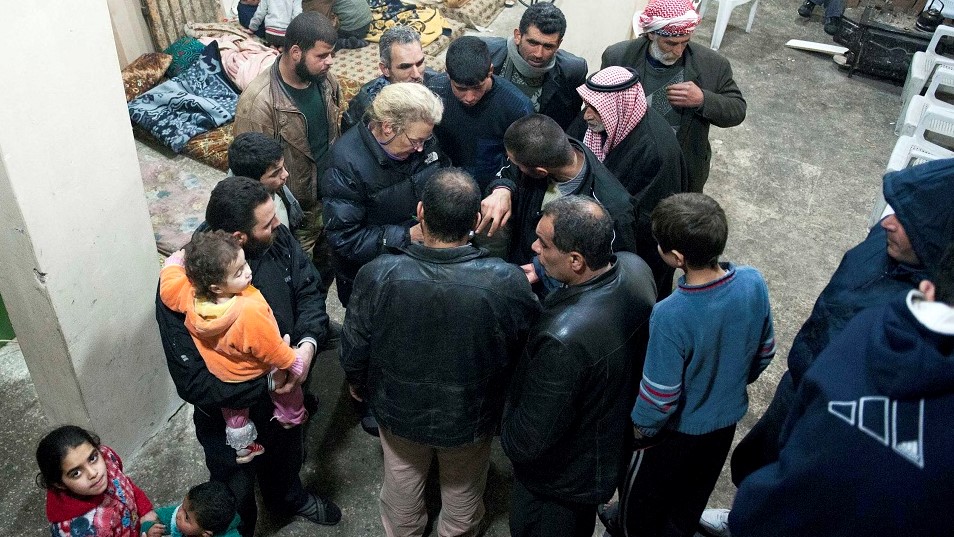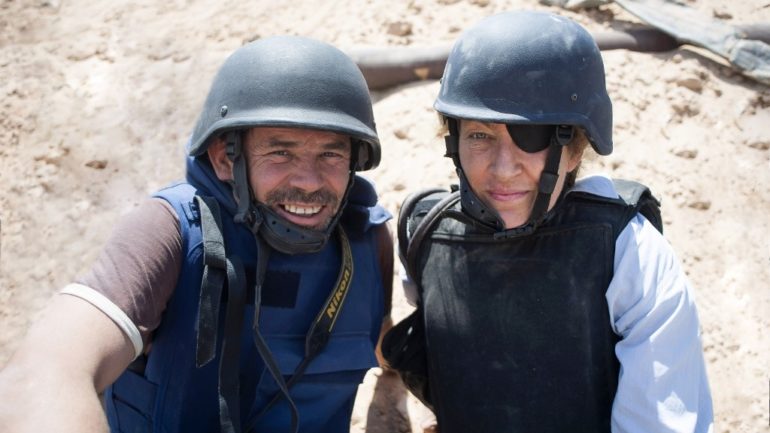Documentary filmmaker Christopher Martin’s latest film, Under the Wire, tells the story of journalists Marie Colvin and Paul Conroy’s epic quest to report on the tragedies taking place during the 2012 Siege of Homs in Syria. The film uses a mix of interviews, footage from the field, and dramatic recreations to bring their efforts to life, and adds stunning realism to two compelling stories: their attempt to cover the conflict; and the lives of those caught in the middle of the Syrian Civil War.
While still transiting through Beirut, American journalist Colvin, British photojournalist Conroy, and other journalists were all denied the documents necessary to grant them legal entry into Syria for the purposes of covering the conflict. But for Colvin and Conroy, two seasoned war correspondents, covering the atrocities in Homs was an itch they simply had to scratch.
On assignment for the Sunday Times, Colvin and Conroy made the decision to enter the country illegally, and were then transported over the border by a chain of smugglers and partisans. Eventually they made their way to the outskirts of Homs and were led into the suburb of Baba Amr through a storm drain that served as the supply line through which all of the vital supplies (people, food, ammunition, and information) were fed into and out of Homs and Baba Amr during the siege.
Over the next two weeks or so Colvin and Conroy found themselves in near constant danger from shelling and snipers. But, more importantly, they were able to get up close and personal with the widows, orphans, wounded, aid workers, and combatants embroiled in the conflict.

Marie Colvin with families sheltering in the basement that serves as an air raid shelter in Baba Amr Homs Syria
For Colvin, who is regularly counted among the most accomplished war correspondents of the 20th and 21st centuries, Syria was a cause that ignited her need to help, and her instinct for telling a story that could move people (decision makers) to action. Her reporting from East Timor in 1999 is credited with saving the lives of some 1,500 refugees trapped in a UN compound. And her work in Chechnya is similarly praised. That said, Colvin’s uncompromising passion for her work often made it difficult for editors to team her with photographers.
But, in Conroy, the ex-military officer turned photojournalist, Marie forged a bond and a working relationship that allowed them to bring the horror of Homs to the rest of the world in a plea for action, compassion, and resolution on behalf of those who could no longer plead for themselves. From cowering families in basements (The Widow’s Basement), to doctors and aid workers struggling to keep wounds some semblance of clean, and bind broken limbs with string, Colvin and Conroy took the time to go beyond the numbers, and gave names and stories to the horrors of war.
Sadly, as their reportage began to reach the outside world and draw attention to the conflict, they likewise drew attention to themselves. The authorities in Syria began to target them and other journalists (in the makeshift war zone media center). And then, despite the approaching artillery shells, while continuing to cover the story, Colvin and French journalist Remi Ochlik were both killed when a shell struck their location. Conroy and journalist Edith Bouvier were also critically wounded in the attack. Over the next few days they struggled to stay alive, avoid capture/torture, and made their way to safety.
While director Martin’s film is a nearly constant barrage of war footage, raised voices, and the horrors of war, the filmmaker is careful to include extraordinary acts of kindness (made all the more extraordinary for the conditions under which they took place). Likewise, the post-conflict interview segments give a sense of humanity to Colvin, Conroy, and the other journalists.
So, despite it’s being a brutal and often hard to watch film, Under the Wire, is an extremely moving account of life in wartime, and the efforts it takes to tell those stories.

